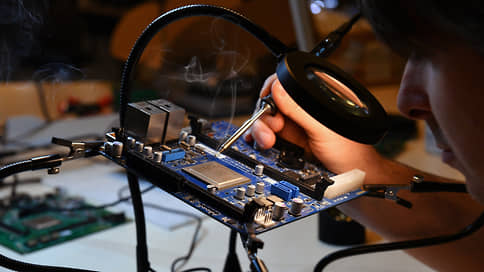Criteria for determining domesticity for telecom equipment are asked to be softened
[ad_1]

Russian manufacturers of telecom equipment and the Ministry of Industry and Trade are arguing about the criteria for determining the domesticity of equipment within the framework of a point system. Sources insist that the requirements proposed by the Ministry of Industry and Trade for the mandatory use of domestic components and printed circuit boards in equipment are impossible to implement under current conditions. Experts see the problem more broadly: the point system in its current form can lead to equipment being recognized as domestic due to the use of simple Russian microcircuits.
According to two Kommersant sources, on December 18, a meeting was held at the Ministry of Industry and Trade on the prospects for introducing a point system for manufacturers of telecommunications equipment. Thus, the draft document, Kommersant sources familiar with the details of the meeting say, suggests that in order to recognize telecom equipment (routers, switches, routers, etc.) as domestic, domestic printed circuit boards, as well as Russian integrated circuits, must be used in its production microcircuits. The share of domestic equipment, interlocutors say, in the composition of products should grow from year to year.
Two of the interviewed meeting participants insist that in the current conditions of a shortage of domestic components for telecom equipment, these requirements are impossible to meet, which is why industry representatives insisted on easing regulation. The Ministry of Industry and Trade confirmed the fact of the meeting to Kommersant. “The document is being studied from the point of view of unifying requirements, similar to calculations for the localization of computer equipment,” said a representative of the ministry.
The domesticity of telecom equipment is determined according to the requirements of Government Resolution 878. To include equipment in the register and receive preferences in the government procurement market, the manufacturer only needs to send documents to the Ministry of Industry and Trade. After this, the equipment and documentation undergo examination by an intersectoral expert council (IEC). The introduction of the new system assumes that the domesticity of equipment will be determined by counting points that the manufacturer gains for performing technological operations, as well as the use of Russian components. Equipment with this approach must undergo the examination of the Chamber of Commerce and Industry, and not the MEA.
The development of a point system to determine the domesticity of telecom equipment has been discussed since the beginning of 2023 (see Kommersant on July 25). In Russia today, electronic components for telecom equipment are not produced, Zelax President Sergei Sukhman is sure. “For a long time, such components were not actually developed or produced in Russia; it was not economically feasible: the Russian market is too small to pay off such developments. Today we are in a situation where mastering the production of such components requires time, large government investments and sufficient demand, at least in the domestic market,” he says. A Kommersant source in one of the telecom equipment vendors agrees with him: “If there is any production of products using Russian components, it is minimal. Basically we are talking about assembly from imported components.” Telecom equipment manufacturer T8 considers the requirements of the Ministry of Industry and Trade “generally sound, but unrealizable right now.”
However, Ivan Pokrovsky, executive director of the Association of Electronics Developers and Manufacturers, sees the issue of assessing the level of localization of telecom equipment more broadly. The problem, he says, is that in both the current and the draft regulation, the criterion does not take into account the functions of Russian components in the product. “In such a situation, the use of a simple Russian microcircuit responsible for the operation of the indicator will provide the same level of localization as a key microcircuit, for example, the switching matrix of a switch,” explains Mr. Pokrovsky. In the first case, he continues, localization should be assessed by assigning a minimum number of points. “And when using Russian key chips, the equipment must be given the first level of preferences not only in terms of localization criteria, but also in terms of trust and security criteria,” he summarizes.
[ad_2]
Source link





